The Technische Nothilfe in the Weimar Republic

TN-Emblem, 1921
The roots of the Technische Nothilfe (TN) were shaped by the military format based upon the Garde-Kavallerie-Schützen-Division (GKSD, Guard Cavalry Rifle Division), a large Berlin troop unit from the days of the revolution 1918/19. Behind this pedantic name hid a union of several Freikorps (free corps), which had placed themselves into the service of the new provisional state government under Friedrich Ebert. The use of the free corps for the new state government was however superficial, as the actual republic loyalty of most volunteer federations, was monarchistic or was a radically right-wing element. The Majority Social Democrats (MSPD) and the military had cooperated in forming an alliance, around which was established a so-called "Dictatorship of the Proletariats" which was to prevent the formation of a Soviet model with all means available.
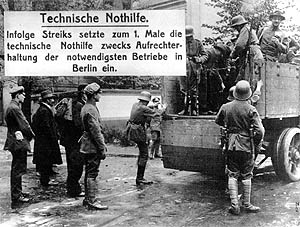
Transport of armed technical time volunteer to their
place of work, 1919:
"Due to strikes the Technische
Nothilfe was
mobilized for the 1st time for maintenance
of the most necessary enterprises in Berlin."
It in most cases the well paid and very well armed free corps succeeded in overpowering rebellions by the use of extreme force, and within a short time the means of the political adversaries seemed at first powerless, except for: countless politically motivated, and often spontaneous wildcat strikes. Since no widely distributed basis of state power existed, the use of these strikes made it possible for a few strikers to paralyze the entire aspects of vital enterprises for gas, water and electricity for all of the rest. In such instances it served no purpose to put together a military force in the vital enterprises or prior to a threaten worker's strike. Calls to national organizations and trade unions to exclude vital enterprises from strike actions did not yield any success. In this situation the architect and Reserve Second Lieutenant Otto Lummitzsch in January 1919 came before the general staff of the GKSD and suggested setting up from technically trained army and naval soldiers a so-called Technische Abteilung (TA, Technical Detachment) which could carry out relief works when there were strikes in vital enterprises. As a result of this plan, technical plants could count on receiving an emergency supply of technically trained workers, the extent of which could be specified by the arranging commander. The TA rapidly assembled several companies. Soon other large free corps followed the model of the GKSD outside of Germany's capital and set up their own technical special-purpose forces for this purpose.
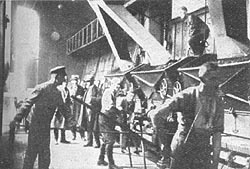
TN emergency aides operate a Berlin
power station, Autumn 1919
However in July, 1919, even with the increase of members of the Berlin TA to 1.100 men, this number was not sufficient any longer, in order to be able to respond effectively to several strike actions in the Reich taking place at the same time. Upon a suggestion by Lummitzsch technical time volunteer federations were set up, which became "on call" and would be mobilized only if necessary. To draw a distinction to the military TA, the collective term "Technische Nothilfe" for these auxiliary groups came in use. Particularly in cities, where both garrisons were located and which were the site of technical universities or other higher institutes, already early TN local groups had been formed. In July 1919, a student named Robert Meldau founded with his fellow students of the Technische Hochschule (technical university) Hanover, the first TN Ortsgruppe (local group) outside of Berlin. The predominant majority of general workers only saw the emergency aides as ordinary strike breakers, one's who weakened the strength of workers and threatened their entitled demands and their long term employment. Gustav Noske, the Reich minister of defense and founding father of the Technische Nothilfe, was criticized for the inexorable hardness of fighting strikes. Thus the emergency aids were insulted as "Noske-Garde" ("Noske's Guard") or "Noske-Hunde" ("Noske's Dogs"). From this initial bad reputation the TN did not come away unscathed, even after it was separated from the Technical Detachments (TA) and converted to a nationwide organization on September 30, 1919.
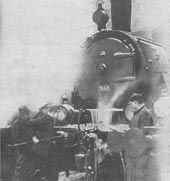
TN men working during
the railway officials' strike,
February 1922
A threat for the continuance of the TN appeared by the regulations of the Treaty of Versailles, which demanded a gradual reduction of the Reichswehr to only 100,000 army soldiers. Since the government realized that it needed to maintain in any case it's most effective means against strikes, the designation of the TN was transferred to the Reich Ministry of the Interior on November 28, 1919. In order to be able to continue to manage the now officially civilian TN, Otto Lummitzsch submitted his resignation from the army, effective January 1, 1920. Nevertheless, the close working interrelationship with the military and police remained in effect.
The twilight the TN almost came about, when it supported the ultra-right subversives during the Kapp-Lüttwitz putsch in the middle of March 1920, since TN forces were used during the general strike proclaimed by trade unions at numerous places. Once again the organization proved to be a true survival artist: After the collapse of the putsch when nearly all renegade troop units were immediately dissolved, the TN came out even more strengthened from the events. Lummitzsch and his deputy, Erich Hampe, understood the circumstances again and again to recommended to each of the often changing Reich governments that they retain and even reinforce the TN.
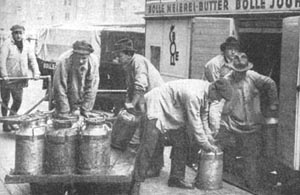
Emergency work in the strikebound
large Berlin dairy Bolle, March 1925
In the early 20's the rapidly growing TN organization expanded its activities to yet further "vital" branches. So meanwhile not only the workers in the supply and transporting enterprises of the large cities did not face the TN personnel with hostility, but also the agricultural workers in Central and East Germany: Against their mostly spontaneous strikes, TN-troops were sent out to take over the harvest work under the protection of police or Reichswehr forces. In addition, for very specialized tasks the TN maintained a cadre of very qualified personnel. During the large railway official's strike at the beginning of February 1922, the TN was able to take action with a great force of skilled men. Within a few days a comprehensive emergency operation was in effect and was maintaining the vital services all over the northern half of the Reich. When there was strike in the Reichsdruckerei (Reich Printing Office) at Berlin, which endangered the printing of the new "Rentenmark" and thus the urgently needed currency reform of November 1923, the TN mobilized printing specialists from everywhere in the country and assured that the currency printing was carried out as an administrative assistance for the very pressured Reich Minister of Finance. The TN reached its highest number of members in 1924/25 with 441,772 male and female members. Formed primarily from civil middle class individuals in technical fields, and those occupations relating to crafts, the role played by students and pupils can not also be underestimated. In contrast to this, workers from particularly most trade unions remained at a distance from the TN and were permanently underrepresented.
Starting from 1924 a general improvement relating to market conditions was in effect. The parties to a wage agreement in the vital enterprises turned to a more pragmatic approach with wage negotiations, which were less combative now in a predominant number. This showed the renewed stronger influence of the free trade unions, which had introduced a strict regulation in the meantime for labor disputes in vital enterprises. Strikes with a political-revolutionary character remained as the exception up to the end of the decade. Also the increasing fear of unemployment worked as a strike-preventing aspect in some industries. All of this led to a drastic decrease for the need of the TN-employments for mobilization during labor disputes. Seizing upon this situation, in 1925, the three relevant trade unions in a rare concord, as well as politicians, which were far distanced from the organization, demanded the complete dismantling of the TN.
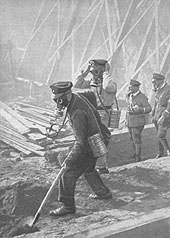
Gas protection exercise of the
TN, 1932
In 1928 at the Hamburg trade union congress, the Social-Democratic Reich Minister of the Interior Carl Severing announced the imminent dissolution of the TN. However, this unjustified demand failed in the long run because of the resistance of the conservative parties in the large coalition, so that the TN remained in existence. Nonetheless, this led to drastic cuts in the budget for the TN, including the dismissals of administrative staff and caused the dissolution of numerous local groups. At the beginning of the 1930's the TN counted still approx. 100,000 members.
To secure the existence of the organization in this critical situation, a realignment took place in two further operating fields: technical disaster relief and air raid protection. Thus the TN, alongside with the fire brigades and medical organizations, was established in many places as the third service in the public disaster defense. Employments with floods, forest fires, mining disasters, and other emergency damage response situations now became the largest part of the work carried out by TN personnel. With their commitment for the air raid protection, the TN worked to end of the 20's even to the point of the development of a completely new kind of civil protection. At the beginning of the 30's the TN finally participated even in the Freiwilliger Arbeitsdienst (FAD, Volunteer Labor Service).